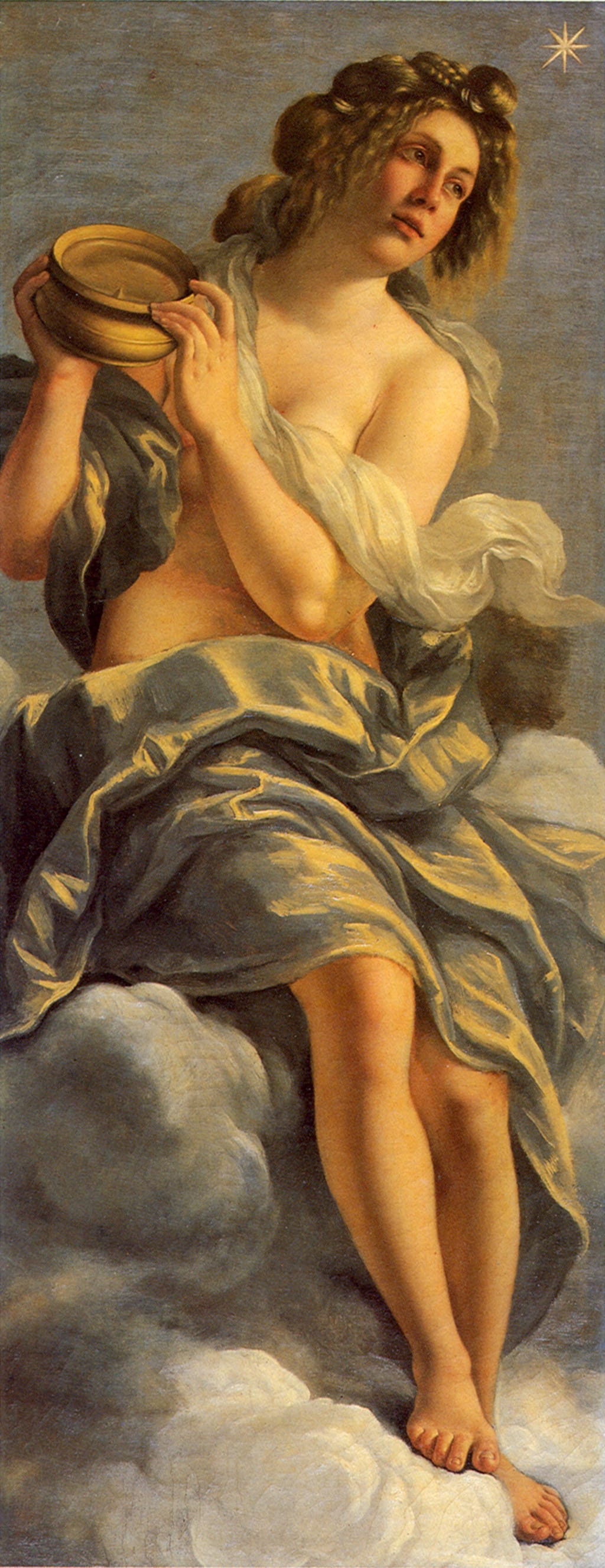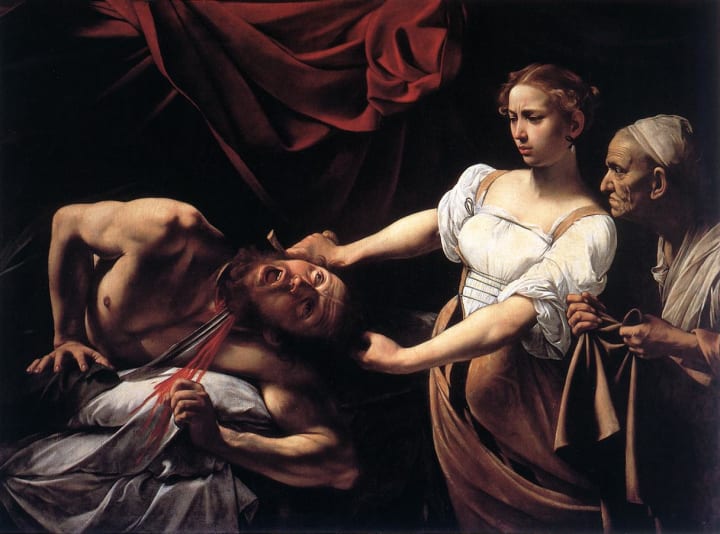An Allegory of Inclination: Conclusion
exploring the art and life of Artemesia Gentileschi, (1593-1656)

[DISCLAIMER: Violence, artistic nudity, child death.]
A candlelit hallway. Enter Artemesia and Tuzia.
ARTEMESIA: Tuzia, do you know the story of Judith, from the Good Book? I want to tell you how important this story is as a theme for the art of Italy.
TUZIA: Is this another one of your hard narrative lessons, Madama Lomi or should I say Stiattesi? Where is that husband of yours these days?
ARTEMESIA: Be silent, you treacherous bitch, puttana infida! it is no lesson. No lesson could teach you. This is only one of my artistic obsessions. Donatello in Florence was the first artist that I know of to tell this story, in his bronze sculpture:

Yet it was Caravaggio much more recently that painted one of the most beautiful canvasses I have ever seen, and hope to rival. My father said it "symbolizes the unity of the Italian commune against Tyranny."

It tells the same story as Donatello, a simple one, do you know it? it's from the Old Testament. Holofernes was an Assyrian general set out to destroy the city of Bethulia in Judea. This was the home of a widow named Judith, a fearsome woman in her faith and devotion. When she heard of the oncoming armies and their doughty captain, she put on her finery and went to his tent outside the city, to offer her body to the conqueror as a whore. She poured him cup upon cup of wine, teasing him slowly with details of her nakedness, until he was so weakened and near losing consciousness, that Judith was able to overcome and behead the fearsome captain of hosts, while her servant assisted. Tell me, would you do that for me, Tuzia?

TUZIA: (clearing her throat) Sure, sounds like fun. I do have to say you certainly have a knack for painting blood soaking into textiles. Did you get any on your dress? Such pretty colors, Madama!

ARTEMESIA: Once the deed was done, they dropped his hairy bearded head almost as ugly as Goliath's in a basket; or in some versions it's set on a silver platter. Thus the conquering pair marched in a jolly and confident mood back to Bethulia with their trophy. End of Story.

PART III: THE FUTURE
Everywhere and Nowhere.
With such a reputation, and such a shocking palette, the renown of Artemesia Lomi Gentileschi will only grow from here. Her savagely beautiful works will be forgotten and rediscovered cyclically, but that will be beyond her reckoning.
The hardest loss she will face is that of her children. Giovanni Battista, Agnola, and Lisabella will none of them reach their first year. Cristofano will die at the age of five. Each one will represent an irreparable rift within and without that no fame can repair.
Her resolution will be forever and sealed, never to paint a Madonna and Child.
Prudenzia, known as Palmira Gentileschi will survive, and is going to embark on her own career as a painter, instructed by her peerless mother. Unfortunately, none of her works will remain to be known to the future.
Artemesia will work in Venice, enriching her colors; she will work in Naples, enriching her line. She will reunite with her father in London at the court of king Charles the First, painting side by side with Rubens and Van Dyck, always thirsty for fresh influences in her craft. She will influence all the art to come, but will not be rediscovered as a serious artist until the twentieth century. She will die an old lady in Naples after many a sweet evening, sipping wine on her balustraded veranda and looking across the Bay at Mount Vesuvius.
FINAL CRITICS: Biblical Heroines in 17th Century Dresses Try to Make Sense of it All

JUDITH: Gendered readings have created far too narrow a field in which to view the innovations that both she and her father have made towards the development of Baroque Art.
SUSANNA: If it's not Baroque, don't fix it. What I actually see here latent in her art is a Political Struggle, a rebellion against the brainwashing of a patriarchal norm that says only men can be violent; it was this supposedly man's world of bloodshed that she embraced in her aesthetic and became more fascinated with than Quentin Tarantino. Were such candid sheets the place for so brutal a massacre? Yes indeed they were. And, this was a woman's Hand? of course it was; there was nothing sadistic here, it was all done impassibly by a true killer at heart.
ESTHER: You're projecting. To be perfectly honest, I don't see what all the fuss is when it comes to Artemesia Gentileschi; while I admit that she is a competent executrix of Baroque tropes, the art that she embodies is a world of imitation invented entirely by men. She did nothing groundbreaking, and her character is also questionable. This Judith is [merely] one of those rehash scenes that her father had already painted and established as valid in that brainwashed and pre-constructed mind of hers he was using as his palette all along. See!

ELIZABETH: So you reject the repressed vengeance theory. Interesting. Still, look down there at the blood, spurting with such feverish intensity, adorning with two spoutlets the central fountain? do you think that just anyone can do that? Her father's work is of course beautiful and heroic, but it is not the same. His inclination is fixed, but on a different star.

So maybe you think she only turns away to avoid the gush of blood which would stain her dress? Impassibility, really? she is impassioned. She was shrewdly exploiting the rape scandal surrounding her person to cater to a male audience drooling for sexually charged female-dominated pictures. Still, she vanquished rather brutally (for herself at least) the prejudice against women in art.
JUDITH: Again, gendered readings have created too narrow a field in which to view the general synthesis of artistic trends anthologized in her work, and to a lesser extent in the work of her father, uniting the pictorial language of the peninsula of Italy into a cohesive whole. But that's enough, ladies.
Exeunt.

ARTEMESIA EPILOGUING AT THE EASEL: (in semi-obscurity, illuminated by a bold shaft of light, working.)
If you asked me why all this violence,
Why all this baring of flesh;
If you asked me why this obsession with blood where
[some demons need to be exorcised]
what can I say? this obsession is aesthetic/
Cathartic//: AN AXIS OF KNOWLEDGE;
Like the Way of All Flesh that they covered with draperies,
Veiling the Nudity of my Inclination.
For, there is a beauty in Blood that eviscerates emotion.
Most primal of colors, it ruddies living flesh,
Fresh when it's reddest of all--
Hematite, or iron-oxide
Like the shimmer of silks, that I paint. In pain
There is a beauty to Blue,
Lengths of cut-out contemplation framed
In the temple of the sky;
There is also splendor to Yellow,
Blasted in deafening solar saturation
Like sunflowers and lemon, an acidic stare. Yet it is
Only the secrets of the shadows that
Shade the growing season
Of your merry floral roundels, and
A truly luscious garden
Must have its butterflies,
AND its weevils.
If you ask me why all this trauma and drama,
Well, I did not decide upon that
With this Hand. It was thrust upon me, so
If you ask me why these obsessions, I fear
All that my ghost can tell you is that
It was my Inclination.

See Part I:
About the Creator
Rob Angeli
sunt lacrimae rerum et mentem mortalia tangunt
There are tears of things, and mortal objects touch the mind.
-Virgil Aeneid I.462
Reader insights
Outstanding
Excellent work. Looking forward to reading more!
Top insights
Compelling and original writing
Creative use of language & vocab
Excellent storytelling
Original narrative & well developed characters
Expert insights and opinions
Arguments were carefully researched and presented
Eye opening
Niche topic & fresh perspectives
Heartfelt and relatable
The story invoked strong personal emotions
On-point and relevant
Writing reflected the title & theme






Comments (6)
When I first discovered "Judith and Holofernes," by Artemesia Gentileschi, I spent at least an hour studying the work. It is brilliant. Thank you for reminding me of why I adore Artemesia and Judith. Bravo!!!
OMIGOSH! Horror and beastly workings most foul. You sure know your Art. Stuff of nightmares, but wonderfully done.
Fascinating story, and the art is amazing. You put this all together so well. have to admit, though I'd never heard of her. But really, I don't know that much about fine art. Well done.
This is incredible. Heartbreaking and powerful. I love art history but knew nothing of this artist so thank you so much for shedding light! It's very rare to here about women creators, especially for the Renaissance Era (if I'm getting my dates correct). Well done, absolutely loved the line "if it ain't Boroque don't fix it" lol!
"Her resolution will be forever and sealed, never to paint a Madonna and Child." That really breaks my heart. A terrible, yet poignant tie in to the first installment. I feel so bad for her losses. "Looking across (oh, typo here "accross) the Bay a Mount Vesuvius." A wonderful reference for how her work had been buried for centuries, or would be buried, if we’re in her POV, there on her veranda. Your metaphors are masterful. Your writing never ceases to amaze me, Rob. That dialogue between the Biblical heroines is a fantastic intermission between her story and the poem at the very end. A clever way to tie in the artistic critique, all the different opinions and theories, while still remaining impartial, yourself. We can only guess as to your own thoughts, though I suspect you align more with Judith here; the gendered reading is too narrow, and I agree. "His inclination is fixed, but on a different star." Ahh, I see now the theme that had begun in the last installment. I love it here! And I agree with Elizabeth’s position more so than the others. Amazing end. That poem is stunning. Her inclination made her obsessions. What a wild life she lived! Absolutely breathtaking work, my friend. 👏🏻👏🏻👏🏻
I don't know if have enough skill or knowledge to really comment on this, but wow! This is something truly special! I was grabbed by the throat and you did not let me go until the end! Fine art is among the things that I know very little about, but through reading this piece I feel as though I've learned something. What that something is, sadly, I don't know for sure